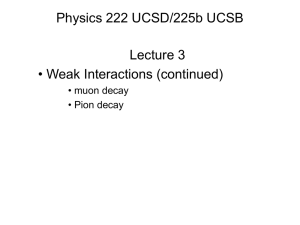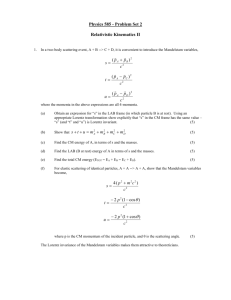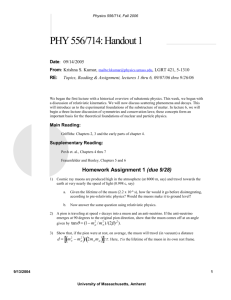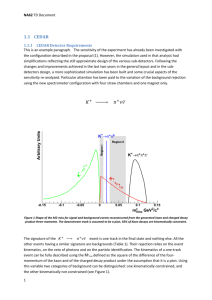Physics 222 UCSD/225b UCSB Lecture 3 • Weak Interactions (continued) • muon decay
advertisement
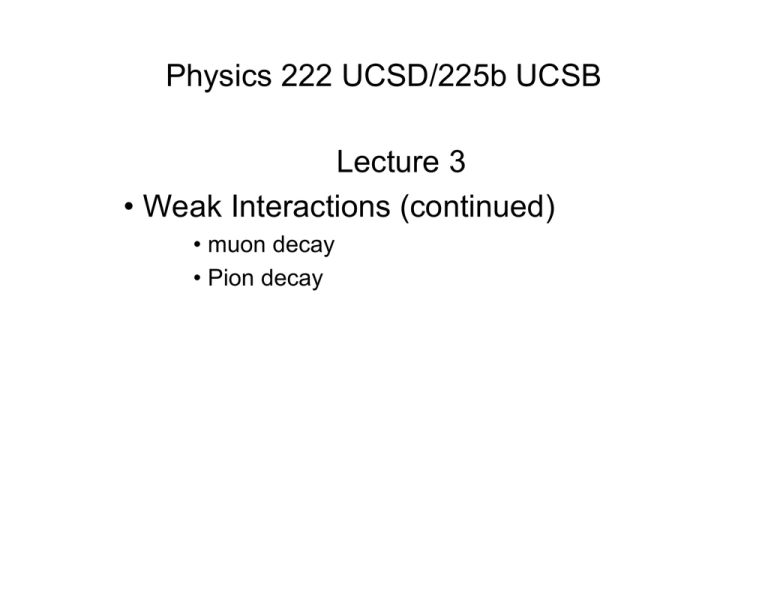
Physics 222 UCSD/225b UCSB Lecture 3 • Weak Interactions (continued) • muon decay • Pion decay Muon Decay Overview (1) ! " u(k) e! " u ( p') • Feynman diagram: µ! " u( p) ! " ! ( k') • Matrix Element: G µ 5 5 M= u ( k )! (1" ! ) u( p) u ( p')! µ (1" ! )v ( k') 2 [ ][ G = effective coupling of a 4-fermion interaction Structure of 4-fermion interaction is (V-A)x(V-A) We clearly want to test this experimentally, e.g. compare against (V-A)x(V+A), S, P, T, etc. ] Muon Decay Overview (2) • Differential width: 1 2 d! = M dQ 2E • Phase space differential: 3 3 3 d p' d k d k' 4 (4 ) dQ = (2! ) # ( p $ p'$k $ k') 3 3 3 (2! ) 2E' (2! ) 2" (2! ) 2" ' Calculational Challenges • There’s a spin averaged matrix element involved, requiring the use of some trace theorems. • The phase space integral is not trivial. I’ll provide you with an outline of how these are done, and leave it up to you to go through the details in H&M. Phase Space Integration (1) • We have: d 3 p' d 3k d 3 k' 4 (4 ) dQ = 2 ! ( ) # ( p $ p'$k $ k') 3 3 3 (2! ) 2E' (2! ) 2" (2! ) 2" ' • We can get rid of one of the three d3p/E by using: d 3k 4 2 $ ! = $d k " (! )# ( k ) • And eliminating the d4k integral against the 4d delta-function. This leads to: ( 1 d 3 p' d 3 k' 4 2 dQ = 2 ! # E $ E'$ " ' % p $ p'$k' ( ) ( ) ( ) 5 2E' 2 " ' (2! ) ) This means E - E’- ω’ > 0 Phase Space Integration (2) • As was done for beta-decay, we replace: d 3 p' d 3 k'= 4 !E'2 dE'2!" '2 d" ' d cos# • And evaluate delta-fct argument in muon restframe: ! (( p " p'"k') ) = ! ( m " 2mE'"2m# '+2E'# ' (1" cos $ )) 2 2 Recall: primed variables are from second W vertex. Spin Average Matrix Element • We neglect the mass of the electron and neutrinos. • And use the trace theorem H&M (12.29) to arrive at: 1 2 M = ! M = 64G 2 ( k " p')( k'" p) 2 spins 2 Muon Restframe • To actually do the phase space integral, we go into the muon restframe where we find: • 2 kp’ =(k+p’)2 = (p-k’)2 = m2 - 2pk’ = m2 - 2m ω’ Mass of e and nu are ignored Mass nu is ignored 4-mom. cons. Mu restframe • k’p = ω’m • And as a result we get: M = 32G ( m ! 2m" ') m" ' 2 2 2 Putting the pieces together and doing the integration over cosθ, the opening angle of e and its anti-neutrino, we arrive at: G2 d! = 3 dE' d# ' m# ( m $ 2# ') 2" 1 1 m $ E'% # '% m 2 2 1 0 % E'% m 2 The inequality come from the requirement that cosθ is physical. And are easily understood from the allowed 3-body phasespace where one of the 3 is at rest. Electron Energy Spectrum • Integrate over electron antineutrino energy: d! G 2 = 3 dE' 2" 1 m 2 % d# ' m# (m $ 2# ') 1 m$E' 2 d! G 2 2 2 & 4 E' ) = 3 m E' ( 3 $ + ' dE' 2" m * 1 0 , E', m 2 The spectrum can be used to test V-A. This is discussed as “measurement of Michel Parameters” in the literature. Michel Parameters • It can be shown that any 4-fermion coupling will lead to an electron spectrum like the one we derived here, once we allow a “Michel 2E x = Parameter” ρ, as follows: m Measured Value: * '- ! = 0.7509 ± 0.0010 1 d! 2 $4 2 µ = 12x ,1" x + #& x "1)/ (. !" = 0.745 ± 0.008 ! dx 3 %3 + e µ • ρ=0 for (V-A)x(V+A),S,P; ρ=1 for T • ρ=0.75 for (V-A)x(V-A) • With polarized muon beams and measurement of electron polarization, other “Michel Parameters” come into play. Total Decay Width of Muon • Integrate over electron energy: 1 G2 2 != = 3m " 2# G 2m 5 != 192# 3 1 m 2 % 4 E' ( + dE' E' '& 3 $ m *) 0 2 µ! " e!# e# µ $ ! " e!# e# $ ! ! $ " µ # µ# $ Note: Comparing muon and tau decays, as well as tau decays to electron and muon, allows for stringent tests of lepton universality to better than 1%. Pion Decay u d WVud µ! " u ( p) ! " ! (k) • Leptonic vertex is identical to the leptonic current vertex in muon decay. • Hadronic vertex needs to be parametrized as it can NOT be treated as a current composed of free quarks. Parametrization of Hadronic Current • Matrix element is Lorentz invariant scalar. – Hadronic current must be vector or axial vector • Pion is spinless – Q is the only vector to construct a current from. • The current at the hadronic vertex thus must be of the form: q µ f ! (q 2 ) = q µ f ! (m!2 ) = q µ f ! • However, as q2 = mπ2 = constant, we refer to fπ simply as the “pion decay constant”. • All other purely leptonic decays of weakly decaying mesons can be calculated in the same way. There are thus “decay constants” for B0, Bs0, D+, Ds+, K+,etc. Aside: • This sort of parametrization is “reused” also when extrapolating from semileptonic to hadronic decays at fixed q2 – E.g. Using B -> D lnu to predict B -> D X where X is some hadron. – This is crude, but works reasonably well in some cases. Matrix Element for Pion Decay [ ] GVud µ µ 5 M= p + k ) f ! u ( p)" µ (1# " )v ( k ) ( 2 Now use the Dirac Equation for muon and neutrino: u ( p)( p µ ! µ " mµ ) = 0 µ 5 5 u p p ! 1" ! v k = u p m 1" ! ( ) ( ) ( ) => ) )v (k ) µ( µ( k µ! µv(k) = 0 ( Note: this works same way for any aV+bA . ) => u ( p) k µ ! µ 1" ! 5 v ( k ) = 0 => [ G 5 M= mµ f ! u ( p)(1" # )v ( k ) 2 ] Trace and Spin averaging • The spin average matrix element squared is then given by: 2 M = Vud 2 [ 2 G 2 2 µ 5 µ 5 f ! mµ Tr ( p " µ + mµ )(1# " ) k " µ (1+ " ) 2 ] M = 4G Vud f m ( p $ k ) 2 2 2 2 ! 2 µ • You can convince yourself that this trace is correct by going back to H&M (6.19), (6.20). The only difference is the “+” sign. This comes from “pulling” a gamma matrix past gamma5. Going into the pion restframe • We get: p ! k = E" # pk = " ( E + " ) • Where we used that muon and neutrino are back to back in the pion restframe. Pion leptonic decay width • Putting it all together, we then get: 3 3 1 d p d k 2 4 d! = M 2 " ( ) $ (q % p % k ) 3 3 2m" (2" ) 2E (2" ) 2# 2 != 2 G Vud f "2 mµ2 (2" ) 2 2m" & ( ) d 3 p d 3k $ ( m" % E % # )$ ( 3) k + p # ( E + # ) E # Energy conservation 3-momentum conservation Use this to kill int over d3p Pion leptonic width • I’ll spare you the details of the integrations. They are discussed in H&M p.265f • The final result is: 2 G Vud != 8" 2 $ mµ2 ' 2 f "2 mµ2 m" &1# 2 ) % m" ( Helicity Suppression Helicity Suppression • The pion has spin=0 . • Angular momentum is conserved. ⇒ Electron and anti-neutrino have same helicity. ⇒ However, weak current does not couple to J=0 electron & antineutrino pair. mµ2 ⇒ Rate is suppressed by a factor: m!2 2 G Vud !" = 8" 2 $ m ' mµ2 f "2 m"3 &1# ) * 2 % m ( m" G2 5 !µ = m µ 192" 3 2 µ 2 " 2 Helicity suppression Experimentally • As the pion decay constant is not known, it is much more powerful to form the ratio of partial widths: ! (" $ e % e ) # # m = # # ! (" $ µ % µ ) m 2 e 2 µ &m #m ) (( ++ = 1.233 ,10#4 'm #m * 2 " 2 " 2 e 2 µ 2 Experimentally, we find: (1.230 +- 0.004) x 10-4 Aside: Theory number here includes radiative corrections !!! I.e., this is not just the mass ratio as indicated !!! Experimental Relevance • We’ve encountered this a few times already, and now we have actually shown the size of the helicity suppression, and where it comes from. ( ! (" )=m $µ % ) m ! " $ e %e # # # # µ 2 e 2 µ 2 &m #m ) #4 = 1.23 , 10 (m #m + ' * 2 " 2 " 2 e 2 µ Accordingly, pion decay produces a rather pure muon neutrino beam, with the charge of the pion determining neutrino or anti-neutrino in the beam. Origin of Helicity Suppression Recap • The muon mass entered because of the vector nature of the leptonic current. ⇒Either V or A or some combination of aV+bA will all lead to helicity suppression. ⇒In particular, a charged weak current with S,P, or T instead of V,A is NOT consistent with experiment. • In addition, we used: – Neutrinos are massless – Electron-muon universality Window for New Physics via leptonic decays u Example B+ decay 2 G Vub != 8" 2 d WVud $ m ' f m mB & 1 # m )( % 2 B 2 µ Helicity Suppression 2 µ 2 B 2 µ! " u ( p) ! " ! (k) The smallness of Vub and muon mass allows for propagators other than W to compete, especially if they do not suffer from helicity suppression => e.g. charged Higgs
